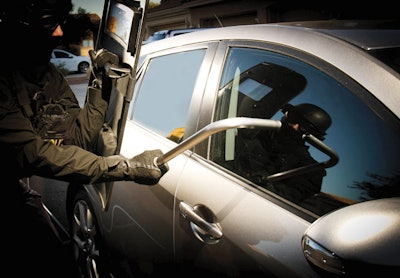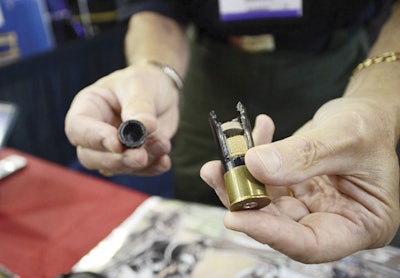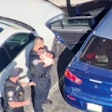 Brite-Strike's PIISA
Brite-Strike's PIISA
We see a lot of products here at POLICE. Each year we go to a wide variety of trade shows and events where manufacturers trot out their newest and best. Our staff and our contributing writers also have numerous opportunities to go hands-on with this stuff.
So we tend to get pretty jaded about new stuff because often the only new thing about new products is a slight improvement or even adjustment. But occasionally there are some products that make us think, "Hey, that's cool."
Here's a look at some products that really impressed or intrigued the POLICE staff in the last 12 months or so. Most are new. Some are just new to us.
Polo with a Chilling Effect
Blauer's B.Cool Performance Polo uses an innovative fabric blend developed to keep officers cooler on the hottest days. The shirt is constructed of lightweight, moisture-wicking polyester and mesh for quick drying and also excellent breathability. Pill resistant, the B.Cool Performance Polo is also designed specifically for law enforcement duty. It features a centered mic tab and a double pen pocket. Available in a wide variety of colors and sizes, including tall sizes.
Booby Trap Simulator
The PIISA from Brite-Strike takes its name from the expression, "It's a pissah," which is popular New England slang for something extraordinary. It was developed to warn soldiers in the field that their perimeter has been breached by potentially hostile troops. The trip-wired alarm system has also proven popular with civilian campers as a wild animal deterrent. And finally law enforcement trainers are using the inexpensive and reusable system as a booby trap simulator.
Bomb Trainer
We've never seen anything quite like the Cyalume police explosive training simulators. These reusable tools can simulate the blast effects of a real bomb using compressed air reservoirs for the boom and chemical powder for smoke. The non-pyrotechnic devices are so safe that officers can even detonate a bomb vest while wearing one in training. The only protective gear necessary is hearing protection because the crack of these "bombs" hits about 140 decibels. It's also recommended that the devices be used outside because the powder/smoke really makes a mess. Cyalume is working on a way to simulate the flash of a bomb in future versions.
 Shieldspike's Hammerspike
Shieldspike's Hammerspike
Shotgun Shock Absorber
Over the years a wide variety of manufacturers have tried to tame the recoil of the 12-gauge police shotgun. Few have done the job better than ITT Enidine, which introduced the Shot Shock last year. Endorsed by the National Tactical Officers Association, the Shot Shock is a hydraulic system recoil buffer integrated into a four-position collapsible butt stock. The result is a marked reduction in felt recoil, almost 70% according to the company's tests.
21st-Century Shotgun
If you were going to design a shotgun for a science-fiction movie, you'd probably conceive something like the Kel-Tec KSG. This bullpup pump shotgun has two magazine tubes and the capacity to carry 12 rounds of hurt. Features include an adjustable stock, a Picatinny rail for mounting the latest optics, and a rubber butt pad to minimize recoil. You can buy a cheaper shotgun, but you won’t find a cooler one.
X-Ray Vision
OK. The Range-R system from L-3 CyTerra won't give you Superman's ability to see through almost everything, but it will give you critical intelligence about what’s behind a wall or a door. Bulky, heavy, unwieldy through-the-wall radar systems have been available for more than a decade, but the Range-R is an example of the next generation of this technology; it's handheld. That makes the Range-R the smallest and lightest wall sensor available, and an extremely useful SWAT tool.
Lightweight Protection
The DeadStop Shields from L.C.O.A. Composites are the lightest ballistic shields on the market, tilting the scales at 10 pounds to 17 pounds. Using L.C.O.A.'s Featherplate armor technology, the DeadStop Shields are not only lightweight but strong; they can stop a .44 Magnum round and are rated NIJ IIIA. The shields feature curved viewports for excellent downrange vision, ambidextrous padded handles, and a curved design to protect operators from tangential attacks. The shield can be combined with an optional high-intensity tactical light.
 Winchester's Segmented Slug
Winchester's Segmented Slug
Early Warning System
The Chameleon from Morphix Technologies is essentially a "canary in the coal mine" for first responders. This easily worn hazardous chemical detection features inexpensive cassettes that change color when exposed to something nasty. The cost-effective Chameleon has been used for several years by the U.S. military but the company only recently started marketing it to law enforcement.
Rechargeable Pocket Light
We have long been fans of the Quiqlite. Invented by a police officer, this inexpensive ($22 to $50), hands-free, LED light is the answer to the officer's need to keep his or her hands available during a traffic stop. The new Quiqlite X is a much-improved product with a lot of cool new features. The Quiqlite X is rechargeable via a USB cable. Also, the new light has two Cree LEDs that can be operated individually. Other improvements include a timer that shuts off the light after 10 minutes to save battery time, a 360-degree rotating magnetic clip for numerous use options, and an anti-glare visor. The Quiqlite X is available in three versions: white LEDs, red and white LEDs, blue and white LEDs.
Palm-Sized Chemist
The RedXDefense XCAT is a handheld device that can reliably identify narcotics, explosives, and gunshot residue in the field. Scaled down from a military tool called the XPAK, the XCAT is easy to use and relatively inexpensive. All the operator has to do is select the test card that matches the suspected substance, then sample a trace amount of the substance. The chemistry happens in the machine, and the operator receives a simple "yes" or "no" via a red light/green light system.
Window Smacker
There are a lot of different ways for emergency personnel to break car windows. We've heard of people using hammers, screwdrivers, rifle barrels, and, of course, the small window punches on folding knives, but we've never seen a better tool for the job than the Shieldspike Hammerspike glass breaker. This 19-inch-long tool weighs 1.5 pounds, is easily wielded in one hand, and can really smack a window. In tactical situations, officers can hold a shield and use the Hammerspike at the same time.
Total Devastation
Some weapons and some ammunition give you the skin-crawling response of "Jeez, I wouldn't want to get hit with that." That's our response to the new Winchester Segmented Slug. This 12-gauge shot shell features a slug that’s kind of a hybrid between buckshot and a slug. Fired from 50 yards out, it performs like a slug. At 40 yards, it breaks into two pieces on impact. And at 30 yards or less, it's devastating, breaking into three pieces at impact. So it's like getting hit with three slugs at once. If you're worried about liability, Winchester has an answer for that, too. The Segmented Slug stays in one piece and flattens out when it hits barrier material such as glass or steel. Winchester says the Segmented Slug eliminates the need for officers to carry both slugs and buckshot. We don’t know about that, but we do know that this thing is going to absolutely ruin the day of anyone it hits at 30 yards or less.


















